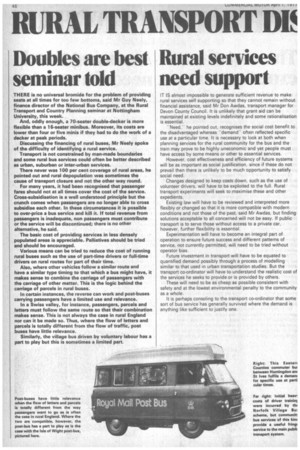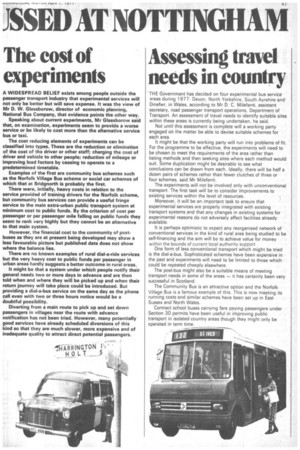RURAL TRANSPORT DO MED AT NOTTINGHAM
Page 48

Page 49

If you've noticed an error in this article please click here to report it so we can fix it.
THERE is no universal bromide for the problem of providing seats at all times for too few bottoms, said Mr Guy Neely, finance director of the National Bus Company, at the Rural Transport and Country Planning seminar at Nottingham University, this week.
And, oddly enough, a 70-seater double-decker is more flexible than a 16-seater minibus. Moreover, its costs are lower than four or five minis if they had to do the work of a decker at peak periods.
Discussing the financing of rural buses, Mr Neely spoke of the difficulty of identifying a rural service.
Transport is not constrained by man-made boundaries and some rural bus services could often be better described as urban, suburban or inter-urban services.
There never was 100 per cent coverage of rural areas, he pointed out and rural depopulation was sometimes the cause of transport closure and not the other way round.
For many years, it had been recognised that passenger fares should not at all times cover the cost of the service. Cross-subsidisation is a well understood principle but the crunch comes when passengers are no longer able to cross subsidise each other. In these circumstances it is possible to over-price a bus service and kill it. If total revenue from passengers is inadequate, non passengers must contribute or the service will be discontinued; there is no other alternative, he said.
The basic cost of providing services in less densely populated areas is appreciable. Palliatives should be tried and should be encouraged.
Various means can be tried to reduce the cost of running rural buses such as the use of part-time drivers or full-time drivers on rural routes for part of their time.
Also, where other vehicles follow a similar route and have a similar type timing to that which a bus might have, it makes sense to combine the carriage of passengers with the carriage of other matter. This is the logic behind the carriage of parcels in rural buses.
In certain instances, the reverse can work and post-buses carrying passengers have a limited use and relevance.
In a Swiss valley, for instance, passengers, parcels and letters must follow the same route so that their combination makes sense. This is not always the case in rural England nor can it be made so. Thus, where the flow of letters and parcels is totally different from the flow of traffic, post buses have little relevance.
Similarly, the village bus driven by voluntary labour has a part to play but this is sometimes a limited part. IT IS almost impossible to generate sufficient revenue to make rural services self supporting so that they cannot remain without financial assistance, said Mr Don Awdas, transport manager for Devon County Council. It is unlikely that grant aid can be maintained at existing levels indefinitely and some rationalisation is essential.
"Need," he pointed out, recognises the social cost benefit to the disadvantaged whereas -demandoften reflected specific use at a particular time. It is necessary to look at both when planning services for the rural community for the bus and the train may prove to be highly uneconomic and yet people must have access by some means or other to essential services.
However, cost effectiveness and efficiency of future systems will be as important as social justification, since if these do not prevail then there is unlikely to be much opportunity to satisfy social need.
Changes designed to keep costs down, such as the use of volunteer drivers, will have to be exploited to the full. Rural transport experiments will seek to maximise these and other expedients.
Existing law will have to be reviewed and interpreted more flexibly or changed so that it is more compatible with modern conditions and not those of the past, said Mr Awdas, but finding solutions acceptable to all concerned will not be easy. If public transport is to serve those without access to a private car, however, further flexibility is essential.
Experimentation will have to become an integral part of operation to ensure future success and different patterns of service, not currently permitted, will need to be tried without operator bias.
Future investment in transport will have to be equated to quantified demand possibly through a process of modelling similar to that used in urban transportation studies. But the transport co-ordinator will have to understand the realistic cost of the services he seeks to provide or is provided by others.
These will need to be as cheap as possible consistent with safety and at the lowest environmental penalty to the community as a whole.
It is perhaps consoling to the transport co-ordinator that some sort of bus service has generally survived where the demand is anything like sufficient to justify one. A WIDESPREAD BELIEF exists among people outside the passenger transport industry that experimental services will not only be better but will save expense. It was the view of Mr D. W. Glassborow, director of economic planning, National Bus Company, that evidence points the other way.
Speaking about current experiments, Mr Glassborow said that, on examination, experiments seem to provide a worse service or be likely to cost more than the alternative service bus or taxi.
The cost reducing elements of experiments can be classified into types. These are the reduction or elimination of the cost of the driver or other staff; charging the cost of driver and vehicle to other people; reduction of mileage or improving load factors by ceasing to operate to a predetermined timetable.
Examples of the first are community bus schemes such as the Norfolk Village Bus scheme or social car schemes of which that at Bridgnorth is probably the first.
There were, initially, heavy costs in relation to the service provided of training drivers for the Norfolk scheme, but community bus services can provide a useful fringe service to the main extra-urban public transport system at minimum cost to public funds. By the criterion of cost per passenger or per passenger mile falling on public funds they seem to rank very highly but they cannot be an alternative to that main system.
However, the financial cost to the community of postbuses as they are at present being developed may show a less favourable picture but published data does not show where the balance lies.
There are no known examples of rural dial-a-ride services but the very heavy cost to public funds per passenger in urban areas hardly suggests a better outcome in rural areas.
It might be that a system under which people notify their general needs two or more days in advance and are then told when and where they will be picked up and when their return journey will take place could be introduced. But providing a dial-a-bus service on the same day as the phone call even with two or three hours notice would be a doubtful possibility.
Diverting from a main route to pick up and set down passengers in villages near the route with advance notification has not been tried. However, many potentially good services have already scheduled diversions of this kind so that they are much slower, more expensive and of inadequate quality to attract direct potential passengers. THE Government has decided on four experimental bus service areas during 1977: Devon, North Yorkshire, South Ayrshire and Dinefwr, in Wales, according to Mr D. C. Milefanti, assistant secretary, road passenger transport operations, Department of Transport. An assessment of travel needs to identify suitable sites within these areas is currently being undertaken, he said.
Not until this assessment is complete will a working party engaged on the matter be able to devise suitable schemes for each area.
It might be that the working party will run into problems of fit. For the programme to be effective, the experiments will need to be chosen to meet the requirements of the area rather than listing methods and then seeking sites where each method would suit. Some duplication might be desirable to see what conclusions can be drawn from each. Ideally, there will be half a dozen pairs of schemes rather than fewer clutches of three or four schemes, said Mr Milefanti.
The experiments will not be involved only with unconventional transport. The first task will be to consider improvements to existing services within the level of resources.
Moreover, it will be an important task to ensure that experimental services are properly integrated with existing transport systems and that any changes in existing systems for experimental reasons do not adversely affect facilities already available.
It is perhaps optimistic to expect any reorganised network of conventional services in the kind of rural area being studied to be self-financing and the aim will be to achieve value for money within the bounds of current local authority support One form of less conventional transport which might be tried is the dial-a-bus. Sophisticated schemes have been expensive in the past and experiments will need to be limited to those which could be repeated cheaply elsewhere.
The post-bus might also be a suitable means of meeting transport needs in some of the areas — it has certainly been very successful in Scotland, The Community Bus is an attractive option and the Norfolk Village Bus is a famous example of this. This is now meeting its running costs and similar schemes have been set up in East Sussex and North Wales.
Contract school buses carrying fare paying passengers under Section 30 permits have been useful in improving public transport in isolated country areas though they might only be operated in term time.
































































































